Critical Evaluation Report: Website Design for Tribute Ltd Company
VerifiedAdded on 2023/06/05
|7
|1579
|249
Report
AI Summary
This report provides a critical evaluation of the Tribute Ltd website, examining its design and development processes. It covers aspects such as system requirements analysis, design methodologies (including the adoption of the waterfall methodology), and the use of HTML, CSS, and PHP. The report assesses website usability and accessibility, focusing on adherence to design principles and user experience. It also suggests further enhancements, such as incorporating image animation and improving menu navigation. The evaluation concludes that the website development process was a valuable learning experience, highlighting the importance of system design principles and the integration of various skills to create an attractive and scalable website. The document is available on Desklib, a platform offering a range of study tools and resources for students.
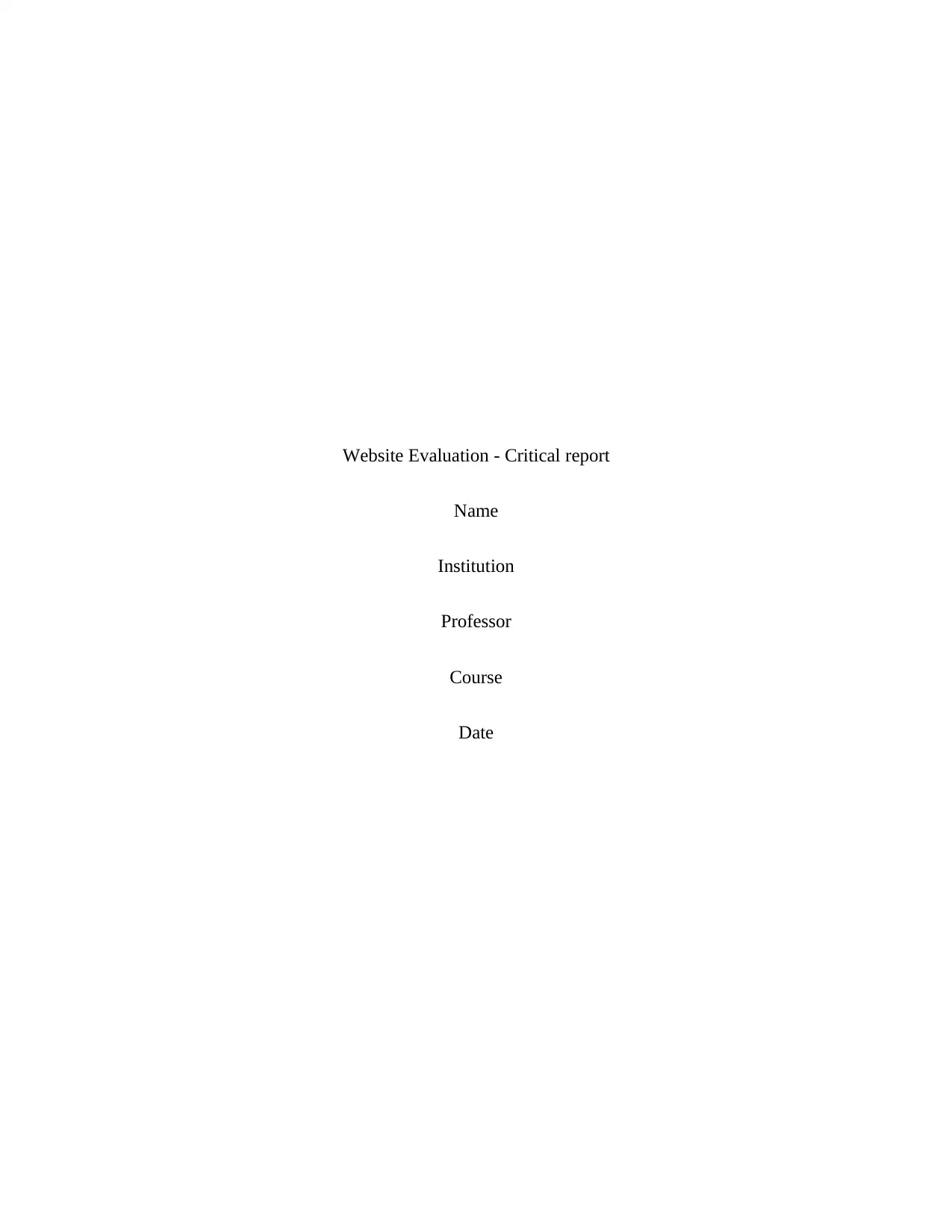
Website Evaluation - Critical report
Name
Institution
Professor
Course
Date
Name
Institution
Professor
Course
Date
Paraphrase This Document
Need a fresh take? Get an instant paraphrase of this document with our AI Paraphraser
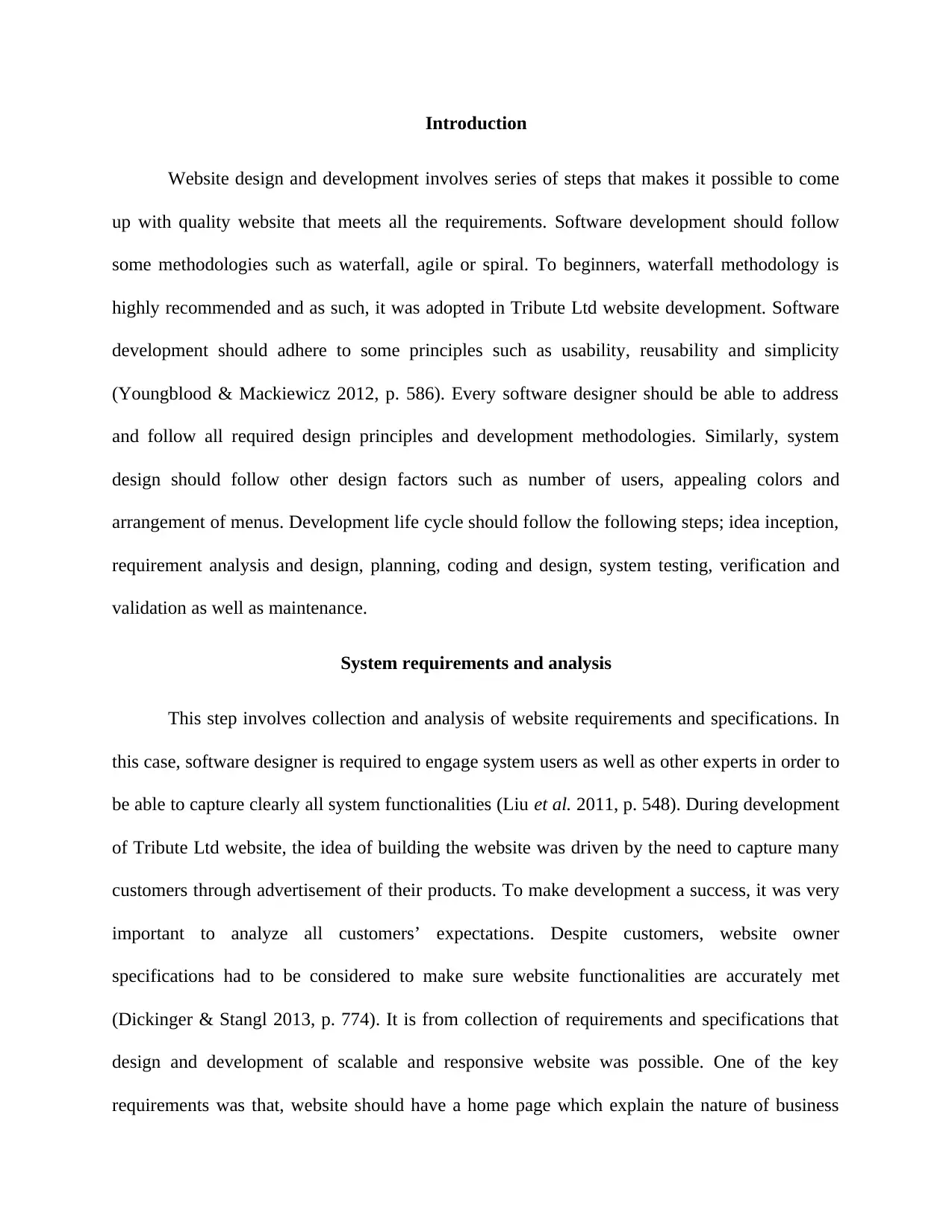
Introduction
Website design and development involves series of steps that makes it possible to come
up with quality website that meets all the requirements. Software development should follow
some methodologies such as waterfall, agile or spiral. To beginners, waterfall methodology is
highly recommended and as such, it was adopted in Tribute Ltd website development. Software
development should adhere to some principles such as usability, reusability and simplicity
(Youngblood & Mackiewicz 2012, p. 586). Every software designer should be able to address
and follow all required design principles and development methodologies. Similarly, system
design should follow other design factors such as number of users, appealing colors and
arrangement of menus. Development life cycle should follow the following steps; idea inception,
requirement analysis and design, planning, coding and design, system testing, verification and
validation as well as maintenance.
System requirements and analysis
This step involves collection and analysis of website requirements and specifications. In
this case, software designer is required to engage system users as well as other experts in order to
be able to capture clearly all system functionalities (Liu et al. 2011, p. 548). During development
of Tribute Ltd website, the idea of building the website was driven by the need to capture many
customers through advertisement of their products. To make development a success, it was very
important to analyze all customers’ expectations. Despite customers, website owner
specifications had to be considered to make sure website functionalities are accurately met
(Dickinger & Stangl 2013, p. 774). It is from collection of requirements and specifications that
design and development of scalable and responsive website was possible. One of the key
requirements was that, website should have a home page which explain the nature of business
Website design and development involves series of steps that makes it possible to come
up with quality website that meets all the requirements. Software development should follow
some methodologies such as waterfall, agile or spiral. To beginners, waterfall methodology is
highly recommended and as such, it was adopted in Tribute Ltd website development. Software
development should adhere to some principles such as usability, reusability and simplicity
(Youngblood & Mackiewicz 2012, p. 586). Every software designer should be able to address
and follow all required design principles and development methodologies. Similarly, system
design should follow other design factors such as number of users, appealing colors and
arrangement of menus. Development life cycle should follow the following steps; idea inception,
requirement analysis and design, planning, coding and design, system testing, verification and
validation as well as maintenance.
System requirements and analysis
This step involves collection and analysis of website requirements and specifications. In
this case, software designer is required to engage system users as well as other experts in order to
be able to capture clearly all system functionalities (Liu et al. 2011, p. 548). During development
of Tribute Ltd website, the idea of building the website was driven by the need to capture many
customers through advertisement of their products. To make development a success, it was very
important to analyze all customers’ expectations. Despite customers, website owner
specifications had to be considered to make sure website functionalities are accurately met
(Dickinger & Stangl 2013, p. 774). It is from collection of requirements and specifications that
design and development of scalable and responsive website was possible. One of the key
requirements was that, website should have a home page which explain the nature of business
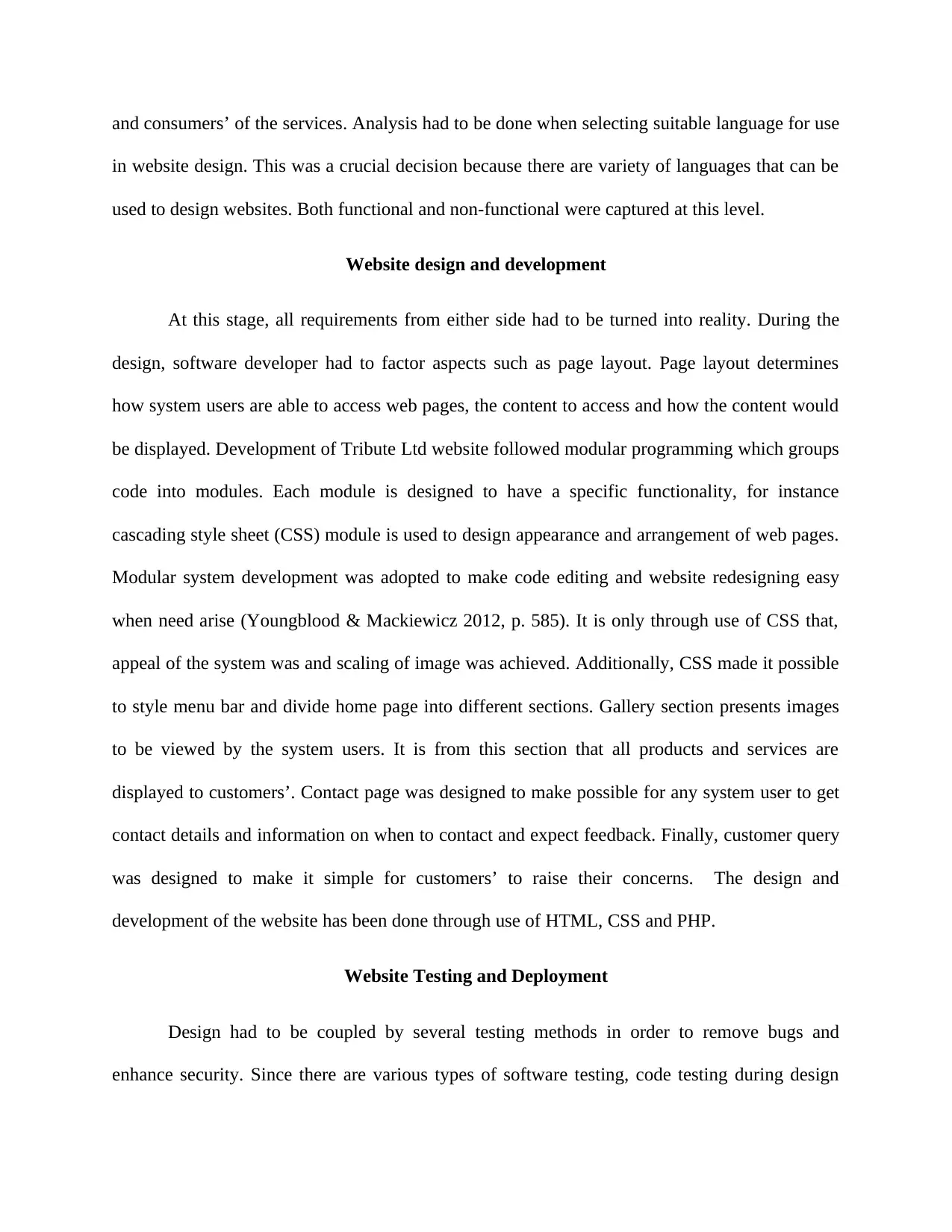
and consumers’ of the services. Analysis had to be done when selecting suitable language for use
in website design. This was a crucial decision because there are variety of languages that can be
used to design websites. Both functional and non-functional were captured at this level.
Website design and development
At this stage, all requirements from either side had to be turned into reality. During the
design, software developer had to factor aspects such as page layout. Page layout determines
how system users are able to access web pages, the content to access and how the content would
be displayed. Development of Tribute Ltd website followed modular programming which groups
code into modules. Each module is designed to have a specific functionality, for instance
cascading style sheet (CSS) module is used to design appearance and arrangement of web pages.
Modular system development was adopted to make code editing and website redesigning easy
when need arise (Youngblood & Mackiewicz 2012, p. 585). It is only through use of CSS that,
appeal of the system was and scaling of image was achieved. Additionally, CSS made it possible
to style menu bar and divide home page into different sections. Gallery section presents images
to be viewed by the system users. It is from this section that all products and services are
displayed to customers’. Contact page was designed to make possible for any system user to get
contact details and information on when to contact and expect feedback. Finally, customer query
was designed to make it simple for customers’ to raise their concerns. The design and
development of the website has been done through use of HTML, CSS and PHP.
Website Testing and Deployment
Design had to be coupled by several testing methods in order to remove bugs and
enhance security. Since there are various types of software testing, code testing during design
in website design. This was a crucial decision because there are variety of languages that can be
used to design websites. Both functional and non-functional were captured at this level.
Website design and development
At this stage, all requirements from either side had to be turned into reality. During the
design, software developer had to factor aspects such as page layout. Page layout determines
how system users are able to access web pages, the content to access and how the content would
be displayed. Development of Tribute Ltd website followed modular programming which groups
code into modules. Each module is designed to have a specific functionality, for instance
cascading style sheet (CSS) module is used to design appearance and arrangement of web pages.
Modular system development was adopted to make code editing and website redesigning easy
when need arise (Youngblood & Mackiewicz 2012, p. 585). It is only through use of CSS that,
appeal of the system was and scaling of image was achieved. Additionally, CSS made it possible
to style menu bar and divide home page into different sections. Gallery section presents images
to be viewed by the system users. It is from this section that all products and services are
displayed to customers’. Contact page was designed to make possible for any system user to get
contact details and information on when to contact and expect feedback. Finally, customer query
was designed to make it simple for customers’ to raise their concerns. The design and
development of the website has been done through use of HTML, CSS and PHP.
Website Testing and Deployment
Design had to be coupled by several testing methods in order to remove bugs and
enhance security. Since there are various types of software testing, code testing during design
⊘ This is a preview!⊘
Do you want full access?
Subscribe today to unlock all pages.

Trusted by 1+ million students worldwide
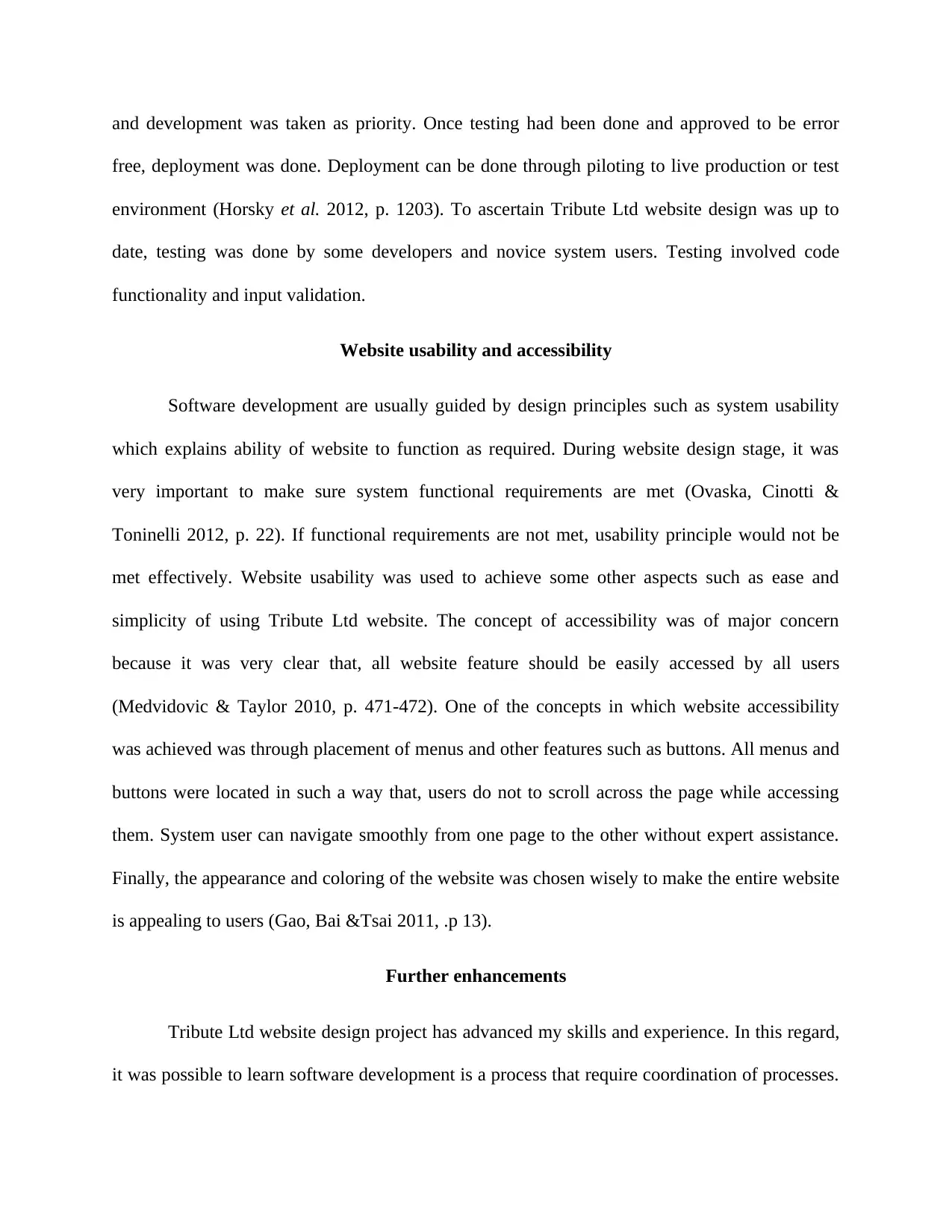
and development was taken as priority. Once testing had been done and approved to be error
free, deployment was done. Deployment can be done through piloting to live production or test
environment (Horsky et al. 2012, p. 1203). To ascertain Tribute Ltd website design was up to
date, testing was done by some developers and novice system users. Testing involved code
functionality and input validation.
Website usability and accessibility
Software development are usually guided by design principles such as system usability
which explains ability of website to function as required. During website design stage, it was
very important to make sure system functional requirements are met (Ovaska, Cinotti &
Toninelli 2012, p. 22). If functional requirements are not met, usability principle would not be
met effectively. Website usability was used to achieve some other aspects such as ease and
simplicity of using Tribute Ltd website. The concept of accessibility was of major concern
because it was very clear that, all website feature should be easily accessed by all users
(Medvidovic & Taylor 2010, p. 471-472). One of the concepts in which website accessibility
was achieved was through placement of menus and other features such as buttons. All menus and
buttons were located in such a way that, users do not to scroll across the page while accessing
them. System user can navigate smoothly from one page to the other without expert assistance.
Finally, the appearance and coloring of the website was chosen wisely to make the entire website
is appealing to users (Gao, Bai &Tsai 2011, .p 13).
Further enhancements
Tribute Ltd website design project has advanced my skills and experience. In this regard,
it was possible to learn software development is a process that require coordination of processes.
free, deployment was done. Deployment can be done through piloting to live production or test
environment (Horsky et al. 2012, p. 1203). To ascertain Tribute Ltd website design was up to
date, testing was done by some developers and novice system users. Testing involved code
functionality and input validation.
Website usability and accessibility
Software development are usually guided by design principles such as system usability
which explains ability of website to function as required. During website design stage, it was
very important to make sure system functional requirements are met (Ovaska, Cinotti &
Toninelli 2012, p. 22). If functional requirements are not met, usability principle would not be
met effectively. Website usability was used to achieve some other aspects such as ease and
simplicity of using Tribute Ltd website. The concept of accessibility was of major concern
because it was very clear that, all website feature should be easily accessed by all users
(Medvidovic & Taylor 2010, p. 471-472). One of the concepts in which website accessibility
was achieved was through placement of menus and other features such as buttons. All menus and
buttons were located in such a way that, users do not to scroll across the page while accessing
them. System user can navigate smoothly from one page to the other without expert assistance.
Finally, the appearance and coloring of the website was chosen wisely to make the entire website
is appealing to users (Gao, Bai &Tsai 2011, .p 13).
Further enhancements
Tribute Ltd website design project has advanced my skills and experience. In this regard,
it was possible to learn software development is a process that require coordination of processes.
Paraphrase This Document
Need a fresh take? Get an instant paraphrase of this document with our AI Paraphraser
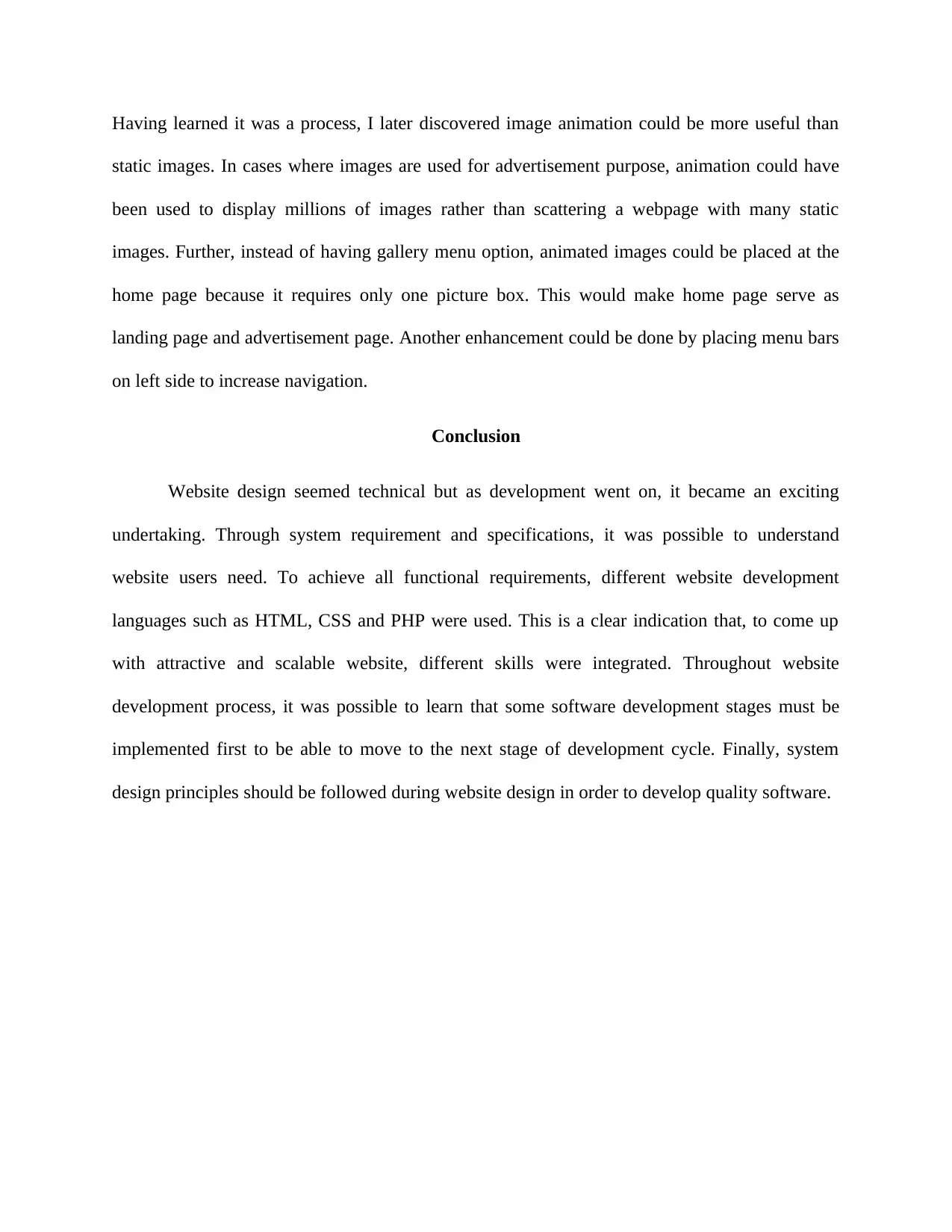
Having learned it was a process, I later discovered image animation could be more useful than
static images. In cases where images are used for advertisement purpose, animation could have
been used to display millions of images rather than scattering a webpage with many static
images. Further, instead of having gallery menu option, animated images could be placed at the
home page because it requires only one picture box. This would make home page serve as
landing page and advertisement page. Another enhancement could be done by placing menu bars
on left side to increase navigation.
Conclusion
Website design seemed technical but as development went on, it became an exciting
undertaking. Through system requirement and specifications, it was possible to understand
website users need. To achieve all functional requirements, different website development
languages such as HTML, CSS and PHP were used. This is a clear indication that, to come up
with attractive and scalable website, different skills were integrated. Throughout website
development process, it was possible to learn that some software development stages must be
implemented first to be able to move to the next stage of development cycle. Finally, system
design principles should be followed during website design in order to develop quality software.
static images. In cases where images are used for advertisement purpose, animation could have
been used to display millions of images rather than scattering a webpage with many static
images. Further, instead of having gallery menu option, animated images could be placed at the
home page because it requires only one picture box. This would make home page serve as
landing page and advertisement page. Another enhancement could be done by placing menu bars
on left side to increase navigation.
Conclusion
Website design seemed technical but as development went on, it became an exciting
undertaking. Through system requirement and specifications, it was possible to understand
website users need. To achieve all functional requirements, different website development
languages such as HTML, CSS and PHP were used. This is a clear indication that, to come up
with attractive and scalable website, different skills were integrated. Throughout website
development process, it was possible to learn that some software development stages must be
implemented first to be able to move to the next stage of development cycle. Finally, system
design principles should be followed during website design in order to develop quality software.
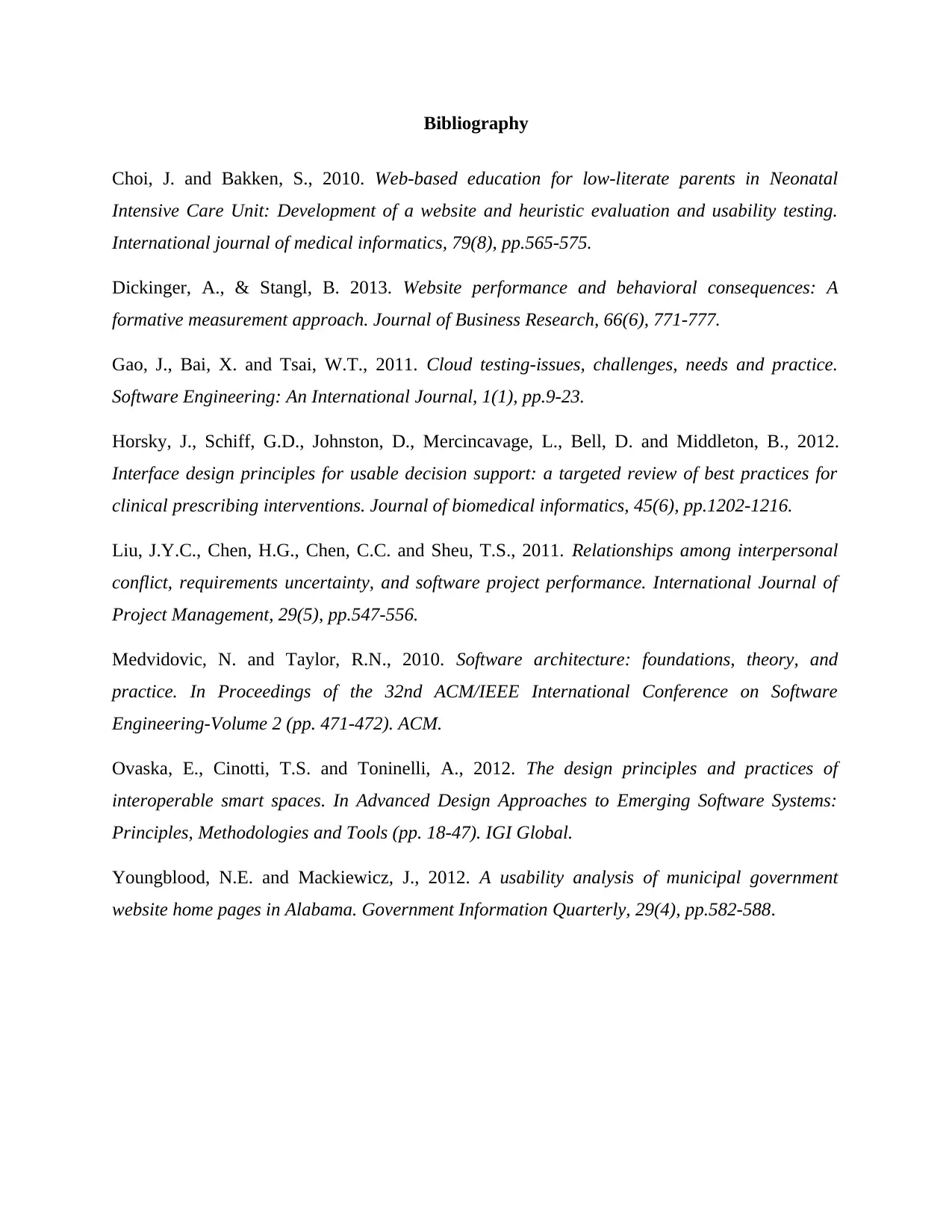
Bibliography
Choi, J. and Bakken, S., 2010. Web-based education for low-literate parents in Neonatal
Intensive Care Unit: Development of a website and heuristic evaluation and usability testing.
International journal of medical informatics, 79(8), pp.565-575.
Dickinger, A., & Stangl, B. 2013. Website performance and behavioral consequences: A
formative measurement approach. Journal of Business Research, 66(6), 771-777.
Gao, J., Bai, X. and Tsai, W.T., 2011. Cloud testing-issues, challenges, needs and practice.
Software Engineering: An International Journal, 1(1), pp.9-23.
Horsky, J., Schiff, G.D., Johnston, D., Mercincavage, L., Bell, D. and Middleton, B., 2012.
Interface design principles for usable decision support: a targeted review of best practices for
clinical prescribing interventions. Journal of biomedical informatics, 45(6), pp.1202-1216.
Liu, J.Y.C., Chen, H.G., Chen, C.C. and Sheu, T.S., 2011. Relationships among interpersonal
conflict, requirements uncertainty, and software project performance. International Journal of
Project Management, 29(5), pp.547-556.
Medvidovic, N. and Taylor, R.N., 2010. Software architecture: foundations, theory, and
practice. In Proceedings of the 32nd ACM/IEEE International Conference on Software
Engineering-Volume 2 (pp. 471-472). ACM.
Ovaska, E., Cinotti, T.S. and Toninelli, A., 2012. The design principles and practices of
interoperable smart spaces. In Advanced Design Approaches to Emerging Software Systems:
Principles, Methodologies and Tools (pp. 18-47). IGI Global.
Youngblood, N.E. and Mackiewicz, J., 2012. A usability analysis of municipal government
website home pages in Alabama. Government Information Quarterly, 29(4), pp.582-588.
Choi, J. and Bakken, S., 2010. Web-based education for low-literate parents in Neonatal
Intensive Care Unit: Development of a website and heuristic evaluation and usability testing.
International journal of medical informatics, 79(8), pp.565-575.
Dickinger, A., & Stangl, B. 2013. Website performance and behavioral consequences: A
formative measurement approach. Journal of Business Research, 66(6), 771-777.
Gao, J., Bai, X. and Tsai, W.T., 2011. Cloud testing-issues, challenges, needs and practice.
Software Engineering: An International Journal, 1(1), pp.9-23.
Horsky, J., Schiff, G.D., Johnston, D., Mercincavage, L., Bell, D. and Middleton, B., 2012.
Interface design principles for usable decision support: a targeted review of best practices for
clinical prescribing interventions. Journal of biomedical informatics, 45(6), pp.1202-1216.
Liu, J.Y.C., Chen, H.G., Chen, C.C. and Sheu, T.S., 2011. Relationships among interpersonal
conflict, requirements uncertainty, and software project performance. International Journal of
Project Management, 29(5), pp.547-556.
Medvidovic, N. and Taylor, R.N., 2010. Software architecture: foundations, theory, and
practice. In Proceedings of the 32nd ACM/IEEE International Conference on Software
Engineering-Volume 2 (pp. 471-472). ACM.
Ovaska, E., Cinotti, T.S. and Toninelli, A., 2012. The design principles and practices of
interoperable smart spaces. In Advanced Design Approaches to Emerging Software Systems:
Principles, Methodologies and Tools (pp. 18-47). IGI Global.
Youngblood, N.E. and Mackiewicz, J., 2012. A usability analysis of municipal government
website home pages in Alabama. Government Information Quarterly, 29(4), pp.582-588.
⊘ This is a preview!⊘
Do you want full access?
Subscribe today to unlock all pages.

Trusted by 1+ million students worldwide

1 out of 7
Related Documents
Your All-in-One AI-Powered Toolkit for Academic Success.
+13062052269
info@desklib.com
Available 24*7 on WhatsApp / Email
![[object Object]](/_next/static/media/star-bottom.7253800d.svg)
Unlock your academic potential
Copyright © 2020–2025 A2Z Services. All Rights Reserved. Developed and managed by ZUCOL.



